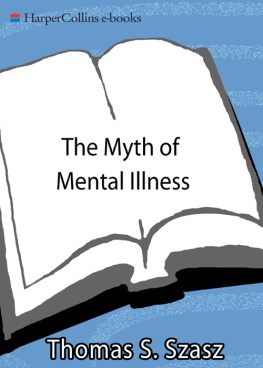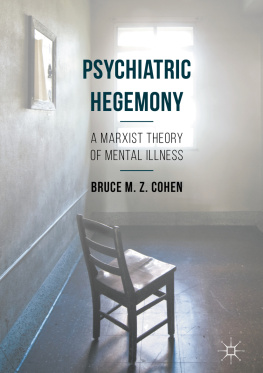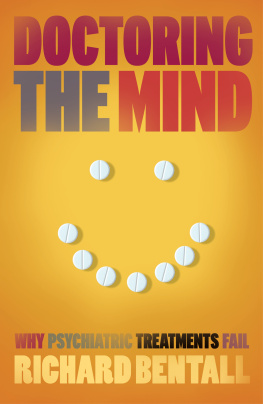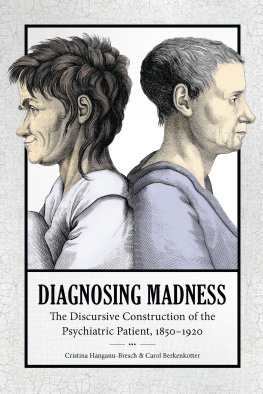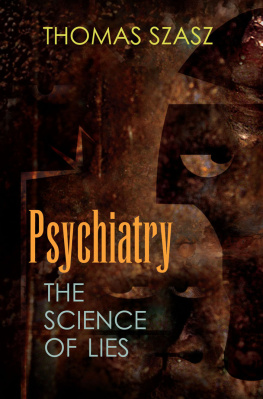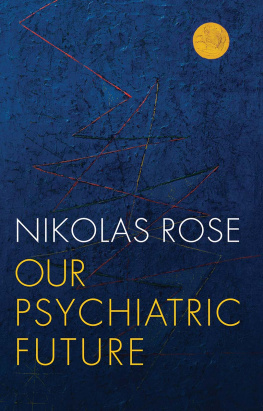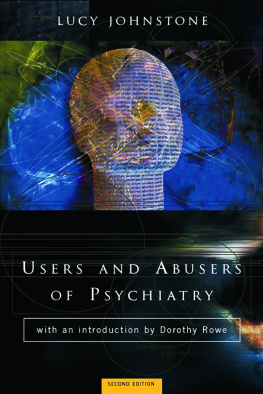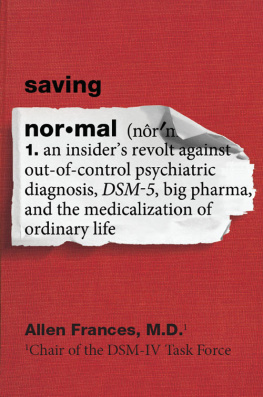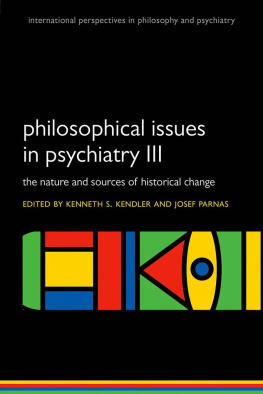THE MYTH OF
MENTAL ILLNESS
Foundations of a Theory of Personal Conduct
Thomas S. Szasz, M.D.

Contents
Preface:
Fifty Years After The Myth of Mental Illness
Good intentions will always be pleaded for every assumption of authority. It is hardly too strong to say that the Constitution was made to guard the people against the dangers of good intentions.
Daniel Webster
1
My aim in this essay is to raise the question Is there such a thing as mental illness? and to argue that there is not. That was the opening line of my essay The Myth of Mental Illness, published in the February 1960 issue of The American Psychologist. The book of the same title appeared the following year.
In the 1950s, when I wrote The Myth of Mental Illness, the notion that it is the responsibility of the federal government to provide health care to the American people had not yet entered national consciousness. Most persons called mental patients were then considered chronic and incurable and were confined in state mental hospitals. The physicians who cared for them were employees of the state governments. Physicians in the private sector treated voluntary patients and were paid by their clients or the clients families.
Since that time, the formerly sharp distinctions between medical hospitals and mental hospitals, voluntary and involuntary mental patients, and private and public psychiatry have blurred into nonexistence. Virtually all medical and mental health care is now the responsibility of and is regulated by the federal government, and its cost is paid, in full or in part, by the federal government. Few, if any, psychiatrists make a living from fees collected directly from patients, and none is free to contract directly with his patients about the terms of the therapeutic contract governing their relationship. Everyone defined as a mental health professional is now legally responsible for preventing his patient from being dangerous to himself or others. In short, psychiatry is medicalized, through and through. The opinion of official American psychiatry, embodied in the American Psychiatric Association, contains the imprimatur of the federal and state governments. There is no legally valid nonmedical approach to mental illness, just as there is no such approach to measles or melanoma.
This is why, fifty years ago, it made sense to assert that mental illnesses are not diseases, but it makes no sense to say so today. Debate about what counts as mental illness has been replaced by legislation about the medicalization and demedicalization of behavior. Old diseases such as homosexuality and hysteria disappear, while new diseases such as gambling and smoking appear, as if to replace them.
Fifty years ago, the question What is mental illness? was of interest to the general public as well as to philosophers, sociologists, and medical professionals. This is no longer the case. The question has been answereddismissed would be more accurateby the holders of political power: representing the State, they decree that mental illness is a disease like any other. Political power and professional self-interest unite in turning a false belief into a lying fact.
In 1999, President William J. Clinton declared: Mental illness can be accurately diagnosed, successfully treated, just as physical illness.
The claim that mental illnesses are diagnosable disorders of the brain is not based on scientific research; it is a lie, an error, or a naive revival of the somatic premise of the long-discredited humoral theory of disease. My claim that mental illnesses are fictitious illnesses is also not based on scientific research; it rests on the materialist-scientific definition of illness as a pathological alteration of cells, tissues, and organs. If we accept this scientific definition of disease, then it follows that mental illness is a metaphor, and that asserting that view is asserting an analytic truth, not subject to empirical falsification.
My great, unforgivable sin in The Myth of Mental Illness was calling public attention to the linguistic pretensions of psychiatry and its preemptive rhetoric: Who can be against helping suffering patients or treating treatable diseases? Who can be for ignoring sick people or, worse, refusing to give patients life-saving treatment? Rejecting that jargon, I insisted that mental hospitals are like prisons, not hospitals; that involuntary mental hospitalization is a type of imprisonment, not medical care; and that coercive psychiatrists function as judges and jailers, not healers. I suggested that we view and understand mental illnesses and psychiatric responses to them as matters of law and rhetoric, not matters of medicine or science.
This sort of rhetorical preemption is, of course, not limited to mental health. On the contrary, it is a popular political stratagem. For example, my late friend, the development economist P. T. Bauer, saw the same sort of deceptive rhetoric controlling the debate about foreign aid: To call official wealth transfers aid promotes an unquestioning attitude. It disarms criticism, obscures realities, and prejudges results. Who can be against aid to the less fortunate?
Although it is intuitively obvious that there is no such thing as a disease of the mind, the idea that mental illness is not a medical problem runs counter to public education, psychiatric dogma defining psychiatry as a branch of medicine and mental disease as brain disease, and relentless medical-political propaganda. Thus, when a person hears me say that there is no such thing as mental illness, he is likely to reply: But I know so-and-so who was diagnosed as mentally ill and turned out to have a brain tumor. In due time, with refinements in medical technology, psychiatrists will be able to show that all mental illnesses are bodily diseases. This contingency does not falsify my contention that mental illness is a metaphor. It verifies it: The physician who discovers that a particular person diagnosed as mentally ill suffers from a brain disease discovers that the patient was misdiagnosed. The patient did not have a mental illness; he had, and has, a physical illness. The physicians erroneous diagnosis is not proof that the term mental illness refers to a class of brain diseases.
In part, such a process of biological discoveries has characterized the history of medicine, one form of madness after another being identified as the manifestation of one or another somatic disease, such as beriberi, epilepsy, or neurosyphilis. The result of such a discovery is that the illness ceases to be a form of psychopathology and is classified and treated as neuropathology. If all the conditions now called mental illnesses proved to be brain diseases, there would be no need for the notion of mental illness and the term would become devoid of meaning. However, because the term refers to the judgments of some persons about the (bad) behaviors of other persons, the opposite is what actually happens: the history of psychiatry is the history of an ever-expanding list of mental disorders.
2
The thesis I had put forward in The Myth of Mental Illness was not a fresh insight, much less a new discovery. It only seemed that way, and seems that way even more so today because we have replaced the old religious-humanistic perspective on the tragic nature of life with a modern dehumanized pseudomedical perspective on it.
The secularization of everyday lifeand, with it, the medicalization of the soul and of suffering of all kindsbegins in late-sixteenth-century England. Shakespeares
Next page
